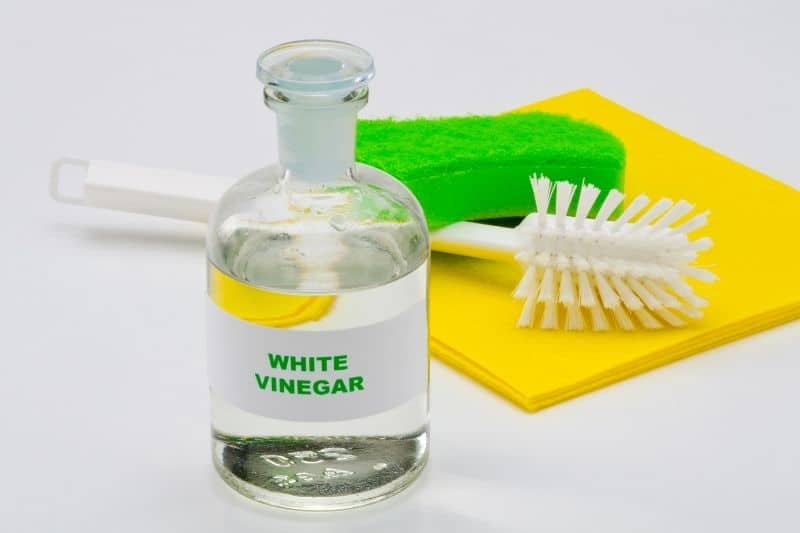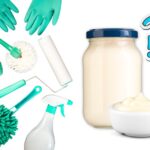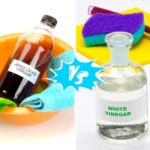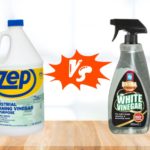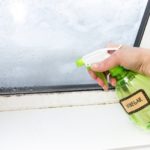White vinegar is one of the most versatile cleaning products. It’s mildly acidic, meaning it can dissolve dirt, stains, and oils, and has natural deodorising and disinfecting properties.
White vinegar is also better suited to cleaning than other types of vinegar as it’s colourless and has a more neutral scent.
But what exactly can you clean with white vinegar? The short answer: a lot!
Everything from kitchens to bathrooms, appliances, glassware, and floors can be cleaned with diluted vinegar.
You can also add bicarbonate of soda, essential oils, lemon juice, or olive oil to give this fantastic natural cleaner extra cleaning properties.
White vinegar is an essential cleaning product that can be used – either by itself, in diluted form, or mixed with other products – to clean many surfaces in your home.
Here are twenty applications and step-by-step guides that you can try at home today.
1. Glass and Windows
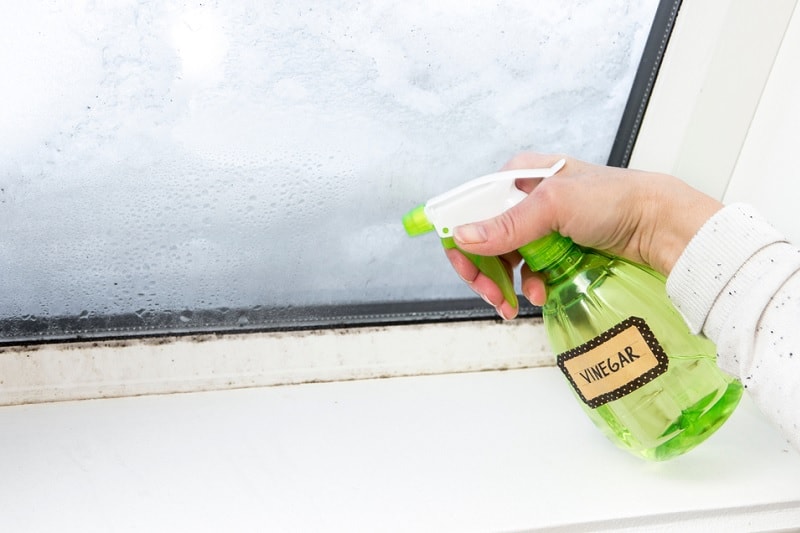
When mixed with water and used in proper proportions, white vinegar can leave glass surfaces streak-free.
This is because it evaporates quickly, preventing the formation of streaks that may occur with some commercial glass cleaners.
Here is how you can use vinegar to clean windows, mirrors, and other glass surfaces in your home:
- Mix equal parts white vinegar and water in a spray bottle.
- Spray the solution onto the glass surface, working from top to bottom.
- Wipe the glass with a lint-free cloth (like a microfibre cloth) or newspaper.
- For stubborn stains, spray the solution and let it sit for a few minutes before wiping.
2. Kitchen Countertops
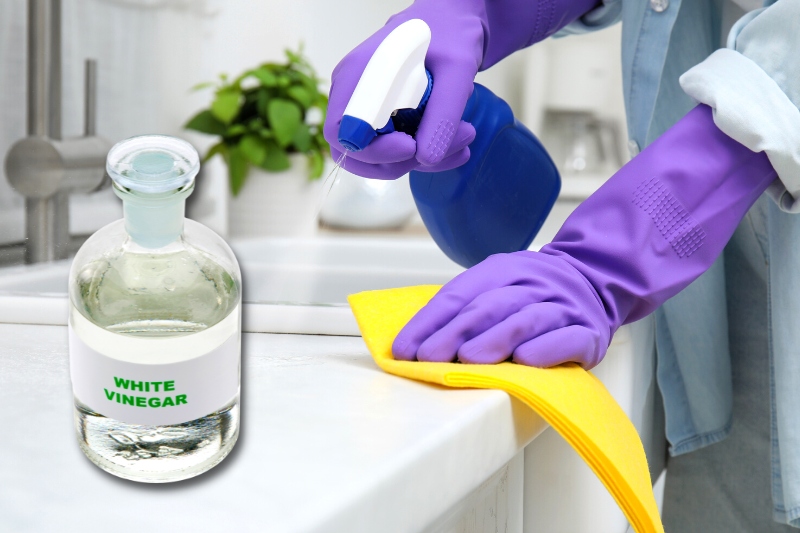
Kitchen countertops often accumulate grease and cooking residue. The acidic nature of white vinegar helps break down and cut through grease, making it effective in degreasing surfaces in your kitchen.
Vinegar also has natural antimicrobial properties and can help kill many household germs. Plus, vinegar has a deodorising effect, neutralising unpleasant odours on kitchen surfaces. This is particularly helpful in areas where food preparation and cooking can leave lingering smells.
Diluted white vinegar can be used to clean many types of kitchen countertop, including silestone and quartz.
Here is how you can make a cleaner using vinegar to use in your kitchen:
- Mix one part white vinegar with one part water in a spray bottle.
- Spray the solution onto the kitchen countertops.
- Wipe down the countertops with a clean cloth or sponge.
- For tougher stains, allow the solution to sit for a few minutes before wiping.
3. Microwave Ovens
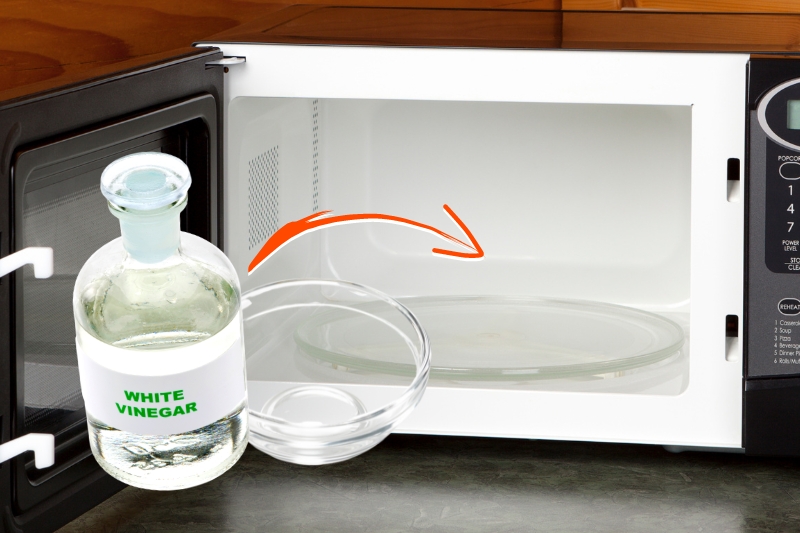
Vinegar is effective for cleaning microwaves as it can produce steam. When mixed with water and heated, vinegar generates steam that helps loosen and soften dried-on food splatters and stains inside the microwave. The grease and grime can then be wiped away effortlessly.
The deodorising properties of vinegar also help remove old food smells left behind from cooking. Here is how to use white vinegar to clean your microwave:
- Mix 250 ml of water with 250 ml of white vinegar in a microwave-safe bowl.
- Place the bowl in the microwave and heat on high for three minutes.
- Without opening the door, let it sit for around five minutes to allow steam to loosen the grime.
- Carefully remove the bowl and wipe the interior with a damp cloth or sponge.
4. Coffee Machines
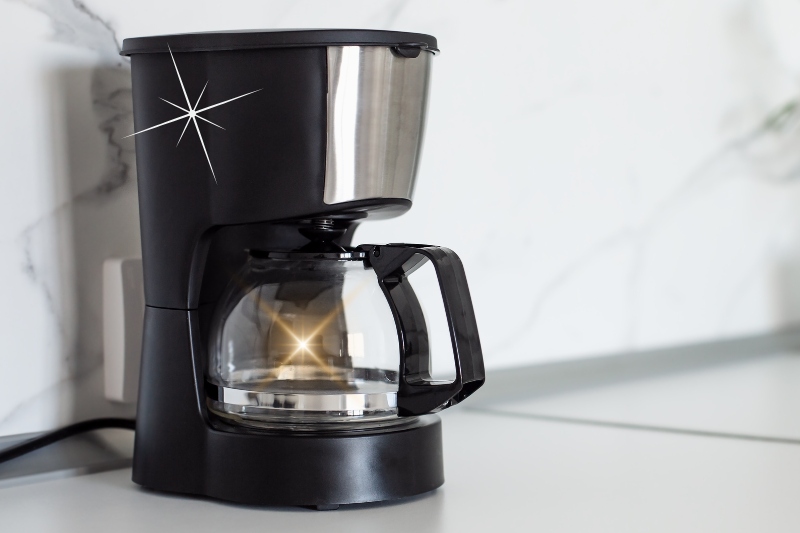
Over time, mineral deposits from water can build up in coffee machines, leading to limescale.
White vinegar can dissolve and remove these mineral deposits, preventing clogs and maintaining the optimal functioning of your coffee maker.
Vinegar is also a non-toxic cleaning solution, making it safe to use in areas that come into contact with food and drink, such as the interior of your coffee machine.
To give it a try, follow these steps:
- Fill the water reservoir in your coffee machine with a mixture of equal parts water and vinegar.
- Run a brewing cycle without coffee grounds.
- Repeat the process with clean water to rinse out any vinegar residue.
5. Dishwashers

Like coffee machines, dishwashers can accumulate limescale over time. These mineral deposits can clog the spray arms and nozzles, preventing your dishwasher from functioning properly.
Running white vinegar through your dishwasher is a quick and easy way to dissolve these deposits.
Another reason that vinegar is successful at cleaning dishwashers is that it neutralises odours caused by food particles and grease.
Additionally, its mild antibacterial properties make it effective at sanitising the dishwasher. This is important in an appliance that comes into contact with dirty dishes.
To use white vinegar to clean your dishwasher, follow these three steps:
- Place a mug of white vinegar on the top rack of an empty dishwasher.
- Run a hot water cycle to help remove soap scum, odours, and mineral deposits.
- You can also sprinkle bicarbonate of soda in the bottom of the dishwasher before running a cycle for additional cleaning power.
6. Bathroom Surfaces

White vinegar can break down and dissolve mineral deposits, soap scum, and grime that commonly accumulates on bathroom surfaces. Its antibacterial properties also help eliminate germs or bacteria that have spread from the toilet, creating a hygienic space for you to shower.
Here is a step-by-step guide on how to make and use a bathroom cleaner using vinegar:
- Pour a solution of half water and half vinegar into a spray bottle.
- Secure the lid and shake the bottle gently to combine.
- Spray the solution onto bathroom surfaces such as sinks, countertops, and shower walls.
- Wipe down with a clean cloth or sponge.
- For stubborn stains, allow the solution to sit for a few minutes before wiping.
7. Toilet Bowls
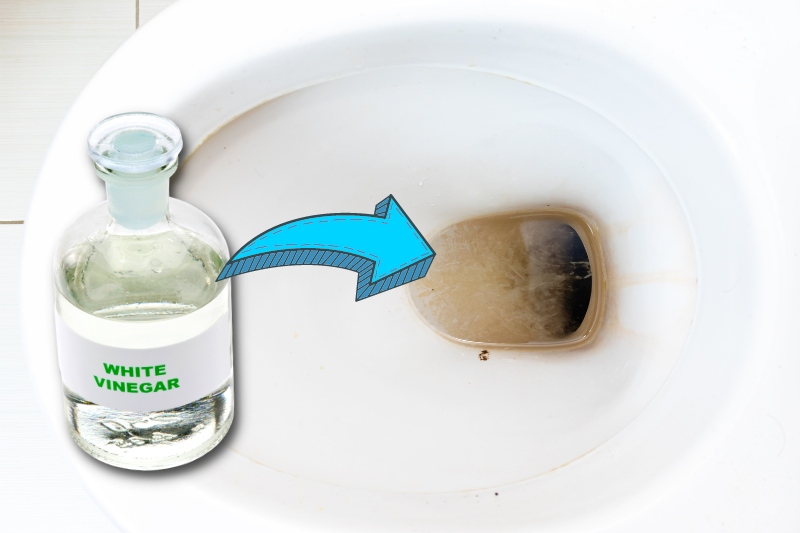
It isn’t just bathroom surfaces that benefit from the antibacterial, deodorising, and acidic properties of white vinegar—you can also use it to clean the toilet bowl and keep it odour-free.
The acidity helps break down and dissolve mineral deposits, limescale, and stains that can accumulate in toilet bowls, whereas its natural disinfectant properties can help kill toilet bacteria.
Meanwhile, its deodorising effect helps neutralise urine odours and leaves the toilet smelling fresher.
Here are the steps for cleaning a toilet bowl with white vinegar:
- Pour about 250 ml of white vinegar directly into the toilet bowl.
- Allow it to sit for at least 15 minutes to break down stains and disinfect.
- Scrub the bowl with a toilet brush to remove grime, dirt, and bacteria.
- Flush to rinse away the white vinegar and any loosened debris.
8. Flooring
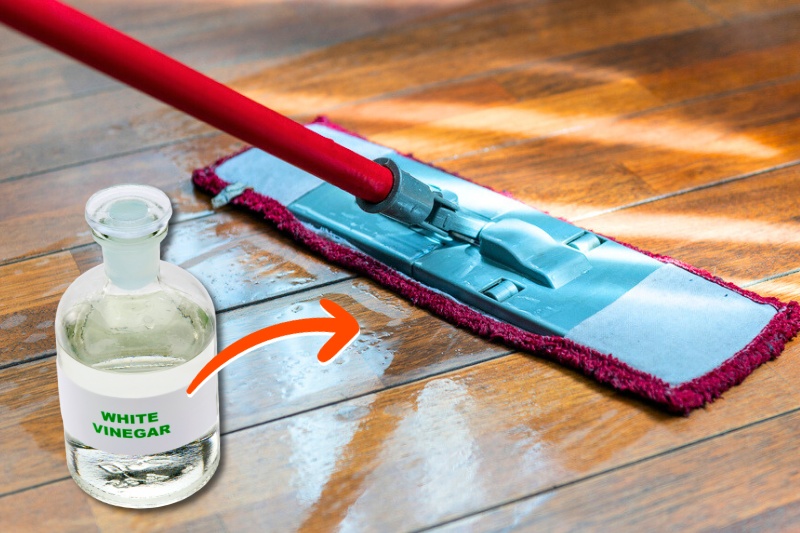
White vinegar can be used to remove stains, grime, and dirt from floors. When diluted, it’s generally safe for a variety of flooring materials, including tile, vinyl, laminate, and sealed hardwood.
It’s a versatile option that can be used on different surfaces without causing damage.
The steps for using white vinegar to clean floors are as follows:
- Add around 250 ml of white vinegar to a bucket of warm water.
- Use the solution to mop various types of flooring, excluding marble and stone.
- Make sure the mop is well-wrung to avoid excess water on the floor.
9. Washing Machines

Over time, mineral deposits from hard water can build up in washing machines, leading to reduced efficiency and unpleasant odours. White vinegar is safe to use in washing machines. Its acidic nature helps dissolve and remove these mineral deposits, preventing clogs in the drum and dispenser.
The antimicrobial properties of vinegar are also invaluable when cleaning washing machines, which frequently come into contact with dirty laundry.
To clean a washing machine using white vinegar, follow these steps:
- Run an empty washing machine on the hottest water setting.
- Add about 500 ml of white vinegar to the washing machine during the rinse cycle.
- This helps remove soap residue and mineral deposits, leaving your machine clean and fresh.
10. Blenders and Food Processors
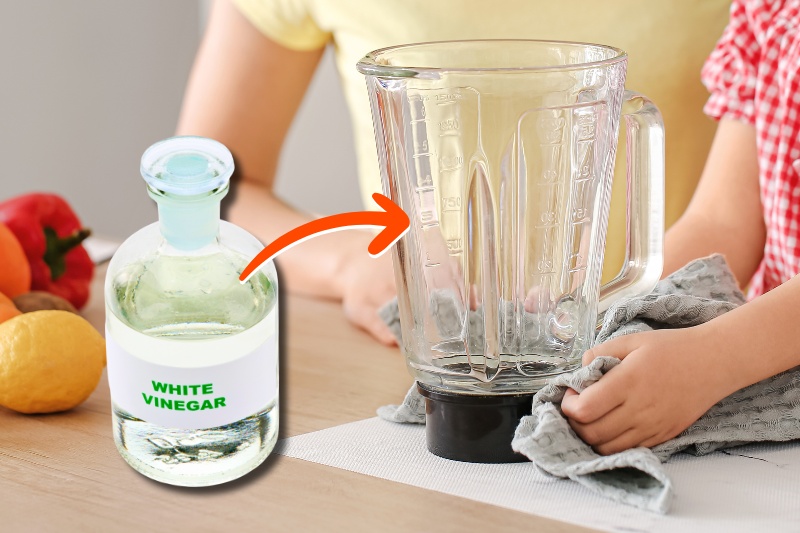
The natural acidity of white vinegar makes it effective at breaking down and dissolving food residues, stains, and deposits that can accumulate in blenders and food processors.
Another reason to consider using white vinegar to clean your blender is that it’s a natural and non-toxic cleaning solution.
It’s therefore safe for use in appliances that come into contact with food, eliminating the need for harsh chemicals that may leave residues on food preparation surfaces.
You can clean your blender and food processor with white vinegar using these instructions:
- Fill your blender or food processor with equal parts white vinegar and water.
- Run the processor or blender to get the solution into all the crevices.
- Let it sit for a few minutes to loosen any stubborn residue.
- Scrub with a brush or sponge, paying attention to blades and corners.
- Wash using washing-up liquid and rinse thoroughly with water.
11. Fridges and Freezers
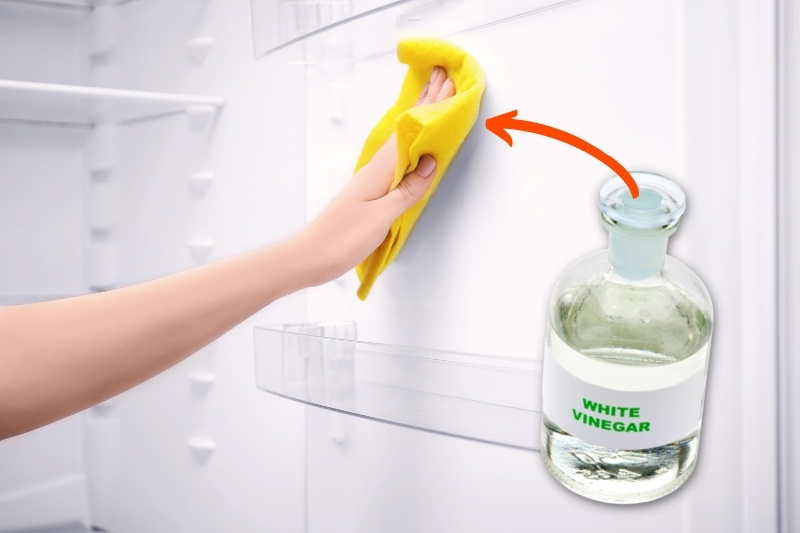
Although not part of a weekly clean, keeping your freezer and refrigerator clean and hygienic is important. After all, this is where you store your food.
You can use white vinegar for cleaning fridges and freezers. Its natural cleaning properties help to maintain a clean and odour-free storage environment for your food.
It’s an affordable and natural solution that effectively keeps these appliances hygienic. Here are the steps you need to follow:
- Pour equal parts white vinegar and water into a spray bottle and shake to combine.
- Remove food items from the fridge or freezer.
- Spray the solution onto surfaces, including shelves and drawers.
- Wipe down with a clean cloth or sponge to remove dirt and grime.
12. Sink Drains
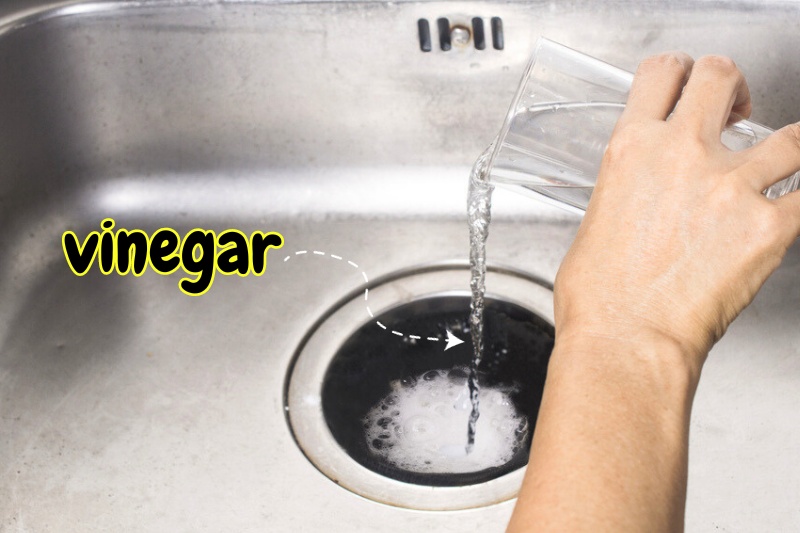
You can use a combination of white vinegar and bicarbonate of soda as a powerful drain unblocker.
It’s effective because of the chemical reaction between the two substances. When vinegar reacts with baking soda, it produces carbon dioxide gas. This creates a fizzing or bubbling action.
The fizzing action helps agitate and break down debris, grease, and other organic matter that may be causing a blockage in the drain.
To clean your sink drain using vinegar, follow these steps:
- Pour about eight tablespoons of bicarbonate of soda down the drain.
- Follow the bicarbonate of soda with 250 ml of white vinegar.
- Immediately cover the drain with a plug or cloth to contain the fizzing reaction.
- Allow the mixture to sit in the drain for 15 to 30 minutes.
- Remove the cover from the drain and slowly pour the boiling water down the drain.
- For stubborn blockages, you may need to repeat the process.
13. Burnt Pots and Pans
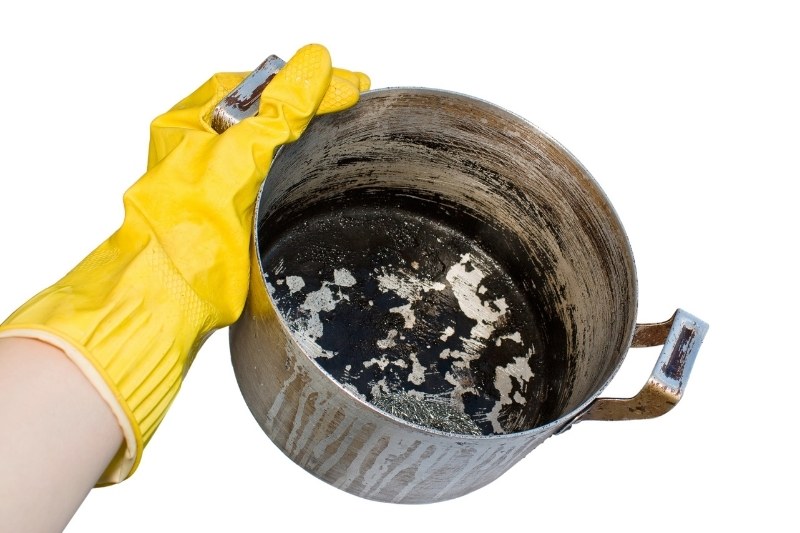
If you can’t shift burnt-on food from your pots and pans with washing-up liquid, white vinegar can provide some extra strength.
The acidic liquid can break down burnt-on stains and food residue without damaging the surface of your cookware.
As a natural cleaning product, it’s also safe for use on surfaces that come into direct contact with food.
Try the following method to clean pots and pans in no time:
- Fill the stained or burnt pot or pan with white vinegar.
- Put the pan on the stovetop and bring it to a boil.
- Allow the pot to simmer for around 10 to 15 minutes.
- Allow it to cool, and then scrub it with a brush or sponge.
14. Plastic Chopping Boards

Regularly cleaning plastic chopping boards with vinegar helps maintain hygiene, eliminate odours, and extend the lifespan.
Soaking the boards in vinegar usually works best. While the chopping boards are soaking, the acidity will cut through stains and odours.
Additionally, although easy to clean, bacteria can build up in the ridges caused by using sharp knives on plastic boards.
Using a natural antimicrobial cleaner like vinegar can help remove these potentially harmful bacteria and stop them from transferring to your food.
To use white vinegar to clean your plastic chopping boards, follow these instructions:
- Soak the plastic chopping board in undiluted white vinegar for a few hours.
- Scrub the board with a brush or sponge.
- Rinse thoroughly with water, then hand wash with washing-up liquid.
15. Cloudy Drinking Glasses
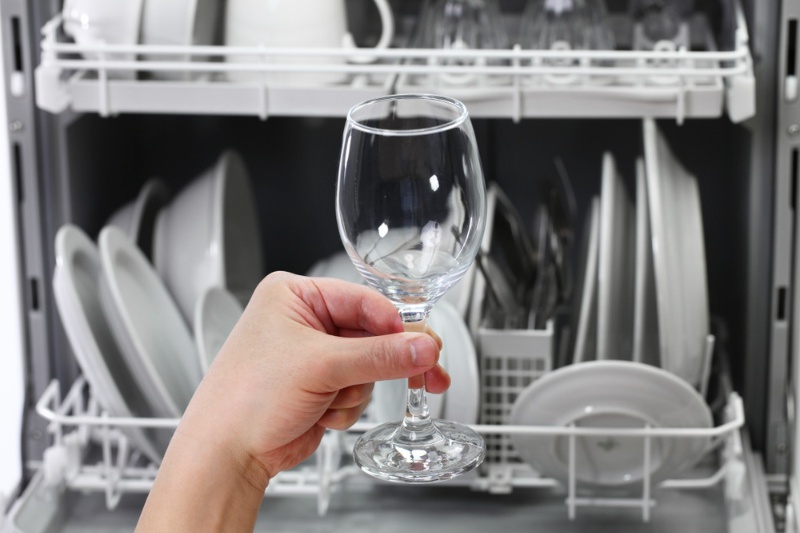
Cloudiness in drinking glasses is often caused by hard water stains, which result from mineral deposits like calcium and magnesium.
White vinegar can effectively get water marks off the glasses by dissolving these deposits and washing them away, restoring the clear and transparent state.
To bring the sparkle back to your glasses using vinegar, use the following method:
- Place the cloudy drinking glasses in your kitchen sink.
- Fill the sink with undiluted white vinegar, ensuring the glasses are submerged.
- Let them soak for a few hours or overnight, then scrub with a brush or sponge.
- Rinse thoroughly with water to remove any vinegar residue.
16. Shower heads
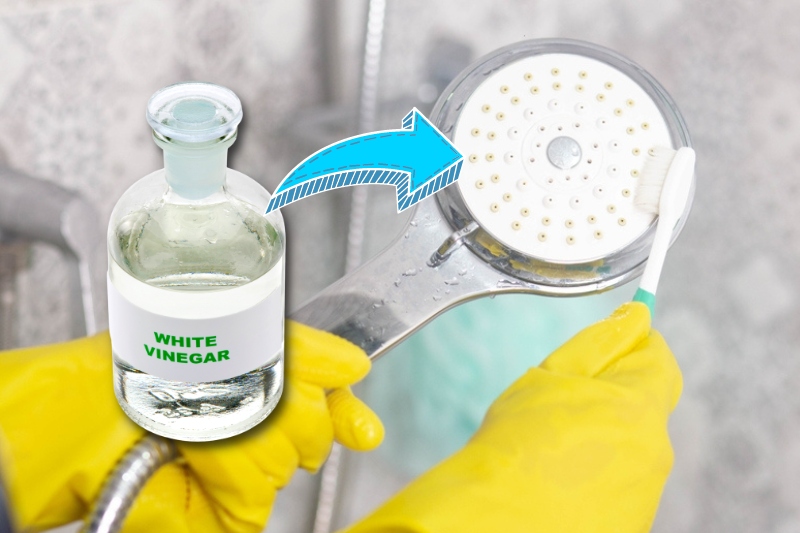
Shower heads can accumulate limescale over time, impacting the flow of water.
Vinegar’s acidic properties make it effective at breaking down and removing these calcium and magnesium deposits.
This process, known as descaling, restores the water flow and prevents clogs, leaving the shower head clean and functioning optimally.
Although many cleaning products can tackle limescale, white vinegar is a great option because of its versatility.
It is safe for various materials commonly used in shower heads, including metal and plastic. You can clean the shower head thoroughly without causing damage to the finish.
To descale a shower head with white vinegar, follow these steps:
- Fill a small plastic bag (such as a freezer bag) with white vinegar.
- Place the bag over the shower head, ensuring it’s fully submerged in the vinegar.
- Secure the bag in place with a rubber band or tie.
- Leave it overnight to allow the vinegar to break down mineral deposits.
- Remove the bag, scrub the shower head with a brush, and run the shower with hot water to rinse it.
17. Stained Teacups and Coffee Mugs

Cleaning teacups and mugs with vinegar is a natural and cost-effective way to maintain their appearance and prevent discolouration over time.
It can dissolve the stains left by tea, coffee, and other beverages, acting as a gentle yet powerful cleaning method.
All you need to do is soak the discoloured mugs in vinegar as so:
- Mix equal parts white vinegar and water in a basin or sink.
- Submerge the teacups or coffee mugs in the solution.
- Let them soak for at least 15 to 30 minutes to help remove stains and odours.
- Scrub the interior and exterior with a sponge or brush.
- Rinse thoroughly with water or wash using washing-up liquid.
18. Chrome Taps and Fixtures
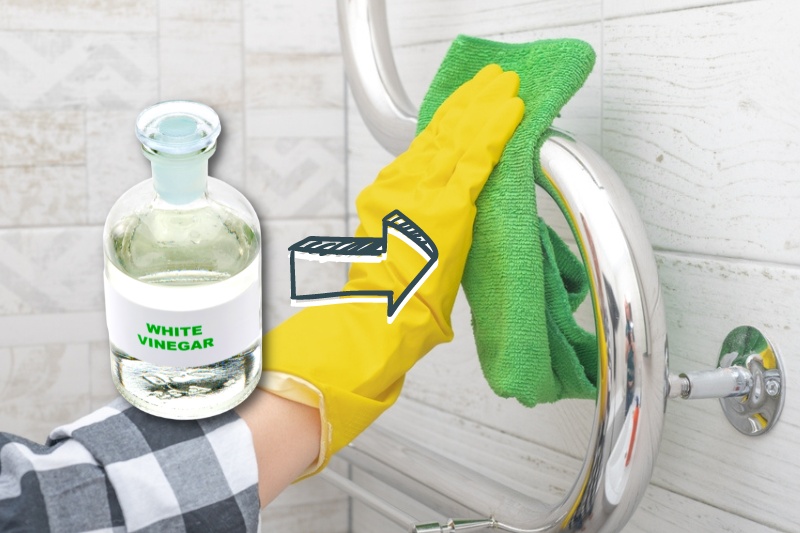
You can clean chrome surfaces with white vinegar. It can be used to clean chrome taps, handles, bathroom fixtures such as towel rails, and other chrome-plated items without causing damage.
The acid in the vinegar can remove mineral deposits, water spots, and tarnishing, helping restore the shine and lustre of chrome fixtures and accessories.
Simply soak a cloth in vinegar and use it to wipe all chrome surfaces in your home as follows:
- Soak a soft cloth (such as a microfibre cloth) in white vinegar.
- Wipe down the chrome taps and fixtures, paying attention to any mineral deposits.
- For stubborn deposits, apply a paste of bicarbonate of soda (baking soda) and vinegar.
- Scrub the paste into the chrome, rinse with water, and dry thoroughly.
19. Wooden Furniture

White vinegar diluted with water can be used to clean wooden surfaces. However, we recommend diluting the vinegar with olive oil for a perfectly polished finish.
The vinegar can dissolve and remove dirt, grime, and stains from wood. It is gentle enough to provide an effective clean without damaging the finish of the wood.
Meanwhile, olive oil is a natural cleaner that can condition wood surfaces. It helps nourish the wood and restore its natural lustre.
The combination of vinegar and olive oil can be particularly beneficial for wood that may have dried out or lost its sheen. Here is the process you need to follow:
- Mix equal parts white vinegar and olive oil in a bowl.
- Dip a soft cloth into the mixture.
- Wipe down wooden furniture, following the wood grain.
- This cleans and conditions the wood, removing dirt and adding shine.
20. Television Screens
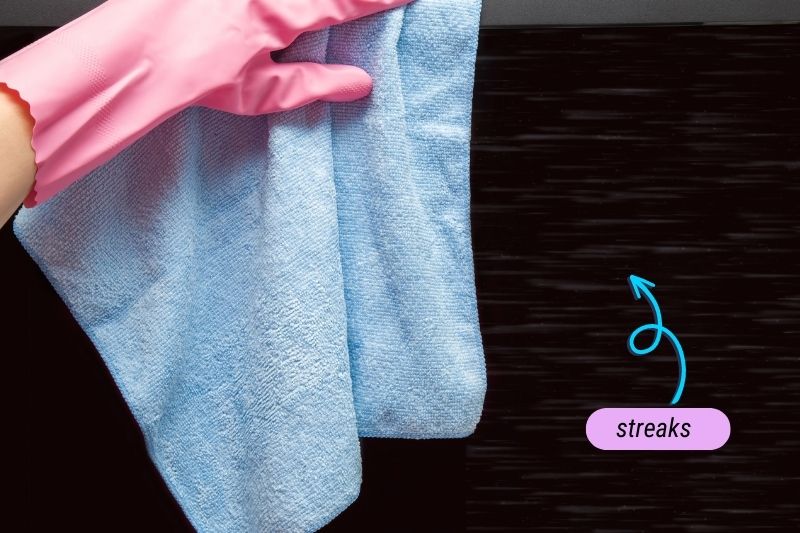
White vinegar is non-abrasive, making it safe for use on delicate surfaces such as TV screens. It won’t scratch or damage the screen’s protective coating.
When diluted with water, it also provides a streak-free finish, breaking down oils, smudges, and fingerprints that can accumulate on TV screens.
Turn your television off first, and then follow these steps:
- Mix equal parts white vinegar and water in a spray bottle.
- Spray the solution onto a microfibre cloth (not directly onto the screen).
- Gently wipe the television screen, ensuring not to press too hard to avoid damage.
- For stubborn spots, dip a corner of the cloth into the solution and gently wipe.
What Surfaces Should NOT be Cleaned with Vinegar?

While vinegar is a versatile and effective natural cleaner, there are certain surfaces and materials that should not be cleaned with vinegar due to potential damage or adverse reactions.
Here are some surfaces to avoid cleaning with vinegar:
- Granite and marble
- Hardwood floors
- Iron or cast iron
- Unsealed grout
- Waxed furniture
- Aluminum or copper
- Porous surfaces (such as unsealed concrete)
Always check manufacturer recommendations and care instructions before using vinegar or any cleaning solution on a specific surface. If in doubt, test a small, inconspicuous area first.
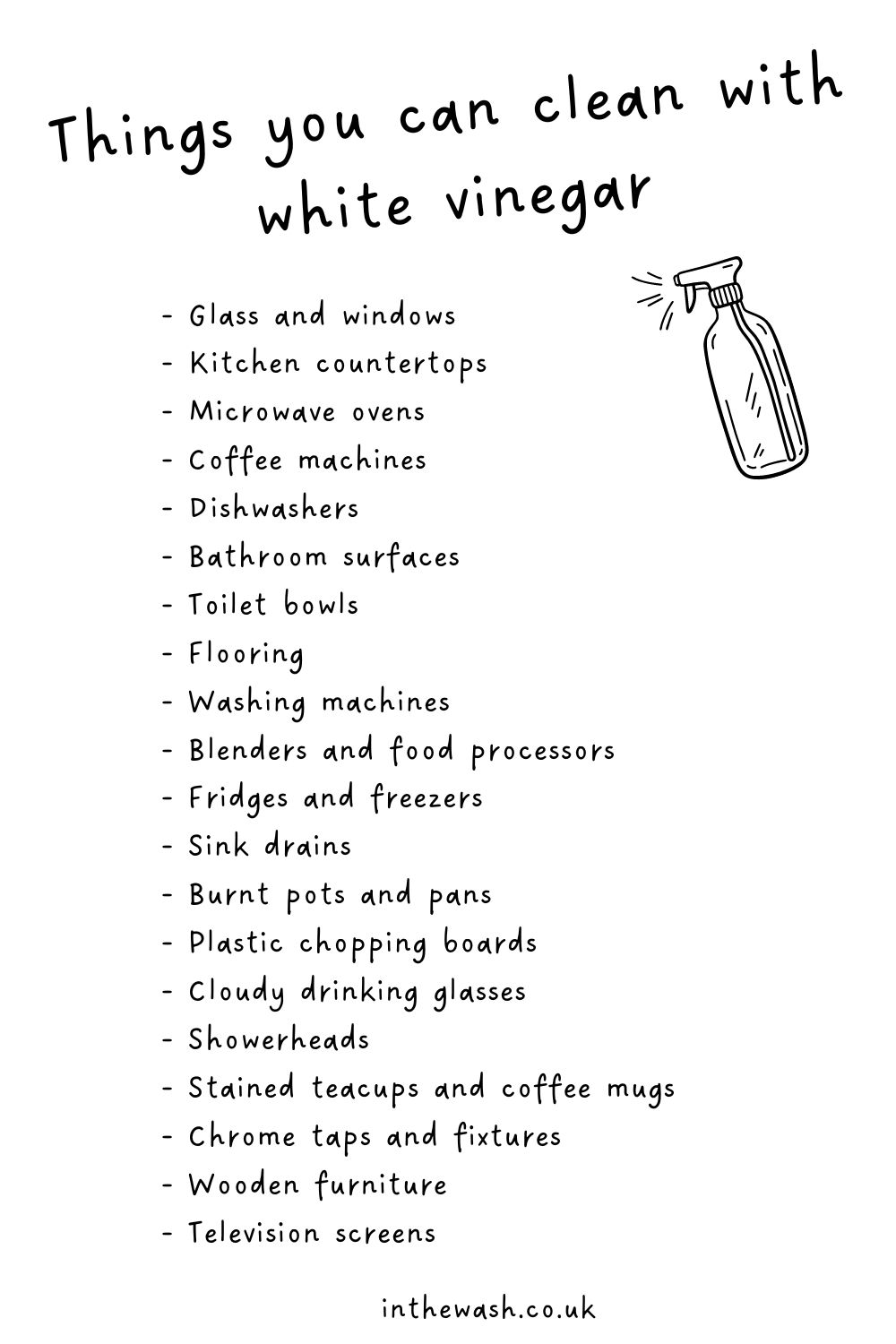

Hannah has a passion for cleaning. She worked her way around Australia by cleaning hostels in exchange for free accommodation and used her cleaning skills to bag a job as a chalet host for a luxury ski company in France.
